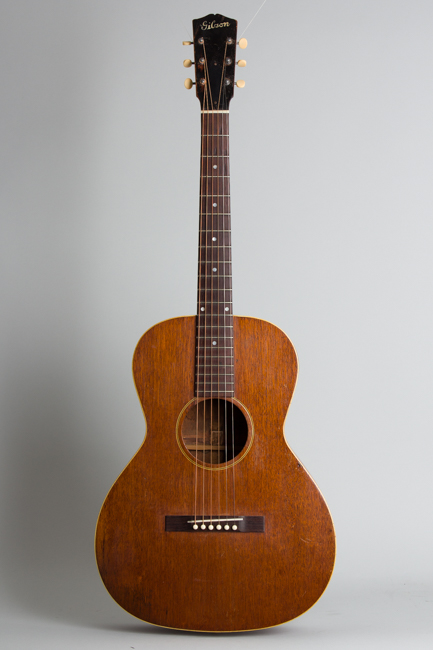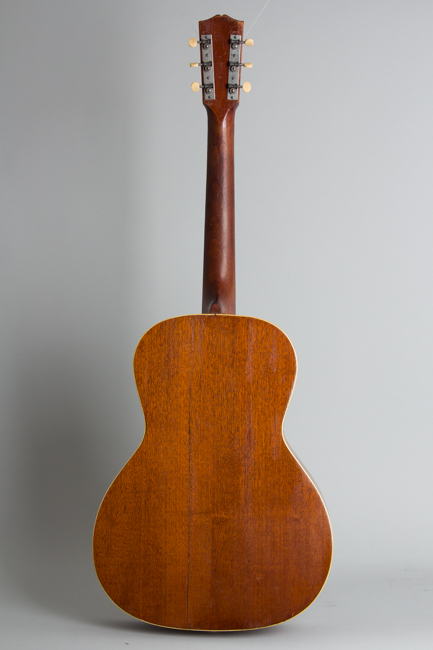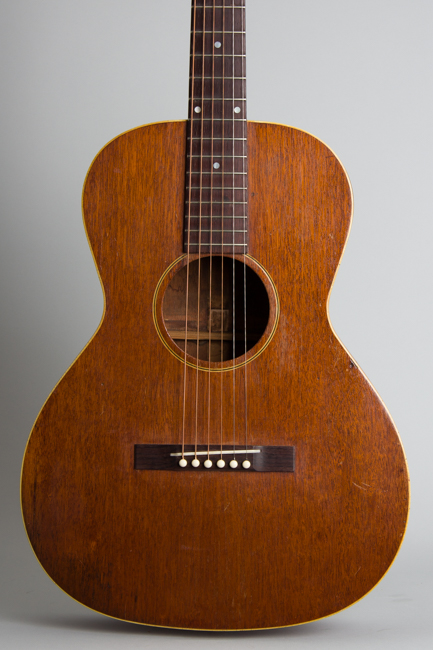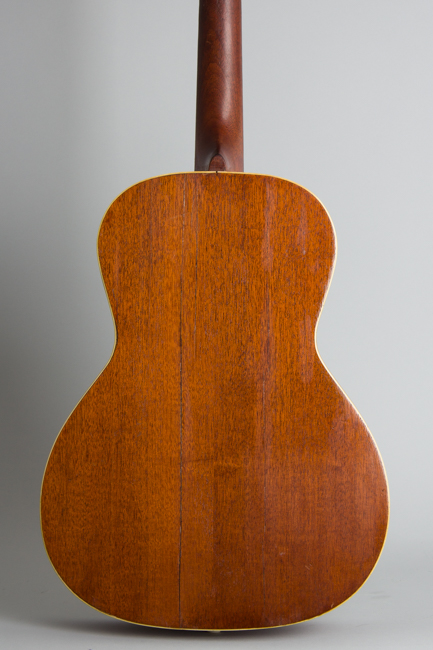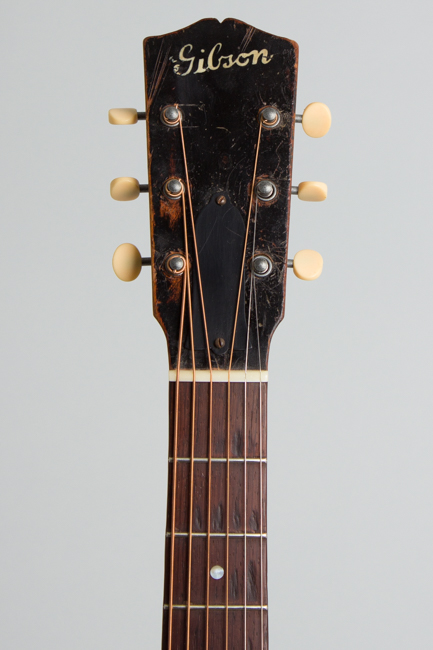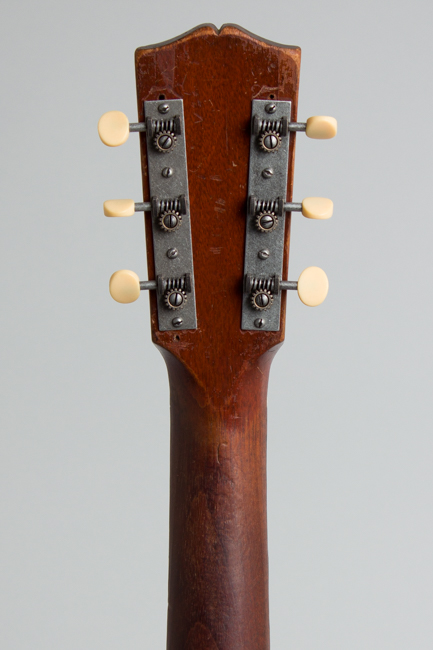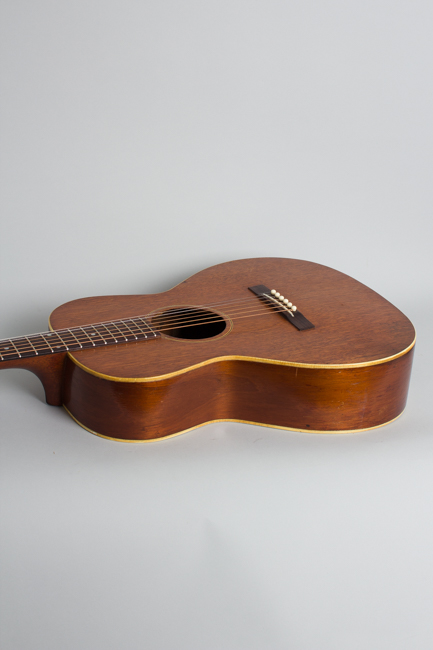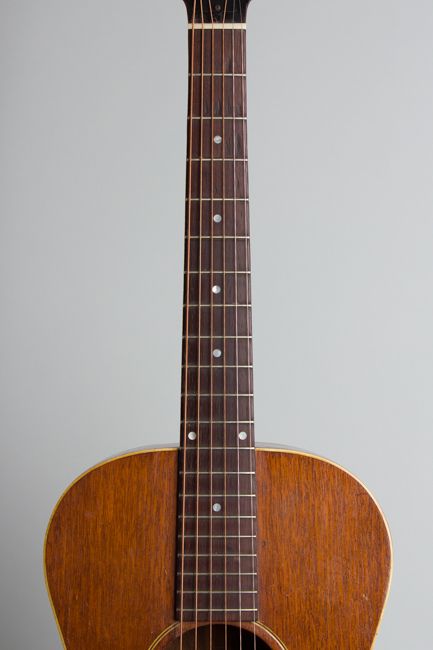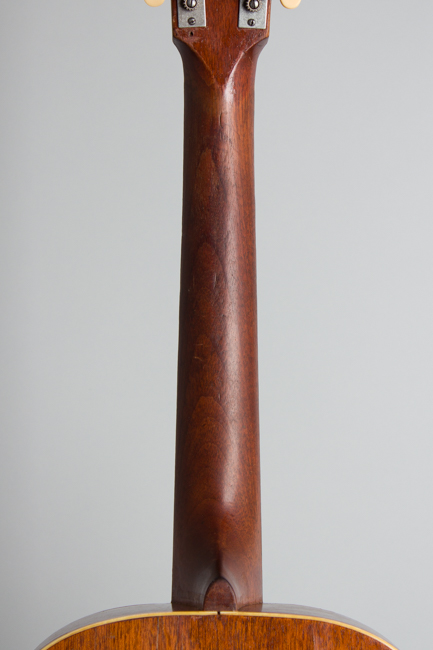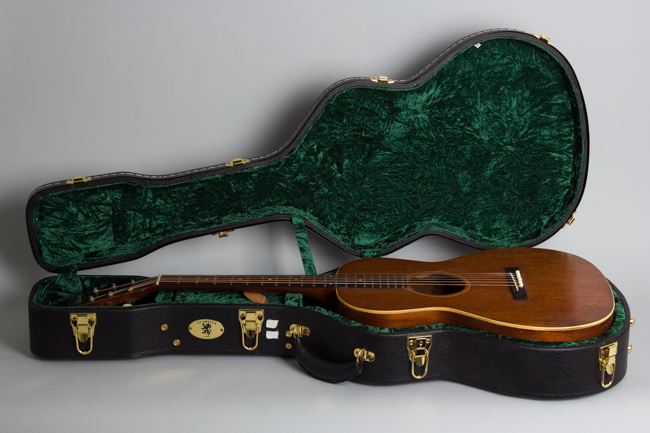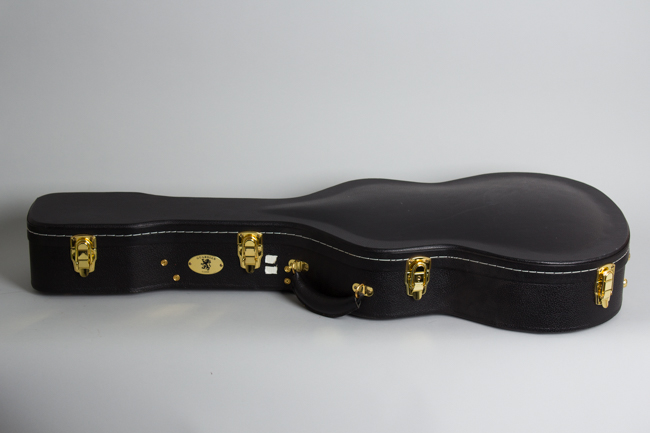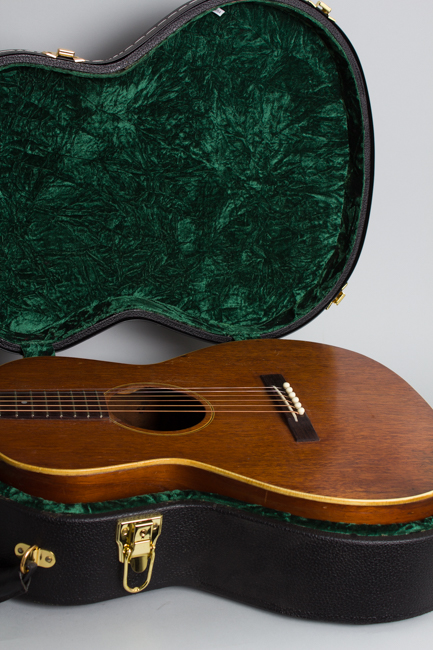Gibson L-0 Flat Top Acoustic Guitar (1932)
This item has been sold.
Item # 9348
Prices subject to change without notice.
Gibson L-0 Model Flat Top Acoustic Guitar (1932), made in Kalamazoo, Michigan, serial # 165, dark mahogany lacquer finish, mahogany body and neck, rosewood fingerboard, black hard shell case.
This is a very heavily played and much-repaired rare Gibson flat-top, still an excellent instrument even with many scars accrued over the last 90 years. This version of the L-0 was produced from around late 1929 into early 1932, during the worst parts of the Great depression. It is an all-mahogany, X-braced guitar, a late example of this version dating to the beginning of 1932. The most notable difference from later models is a 12-fret neck joint, a holdover from the 1920s; Both Gibson and Martin would soon adopt the 14-fret design as standard for flat tops. With a clear natural dark mahogany finish and white celluloid accents, this L-0 maintains an austere but elegant 1920s look but is built on the more "modern" larger body of a 1930s flat-top guitar.
The wider, less rounded body shape and X-braced top introduced on these models in 1929 would be subsequently used on the 14-fret L-0 and L-00 throughout the 1930s, but the all-mahogany construction and natural finish disappeared around 1932. This one has the new larger white paint "Gibson" logo in place of the old small silver script, but is otherwise the same as 1930-31 examples. This neck has a very comfortable and surprisingly slim and modern feeling rounded "C" profile, quite unlike the deeper heavy "V" adopted for these models soon after.
These earliest 12-fret L-0s also feature exceptionally light construction, even compared to mid-1930s examples. This one has seen a lot of use and repair but is still an excellent playing and sounding guitar. While we are partial to all pre-WWII Gibson flat-tops, we find the L-0 from this period to be an austere but attractive and great-sounding guitar, even in this well-worn state a very responsive instrument.
Overall length is 38 1/2 in. (97.8 cm.), 14 3/4 in. (37.5 cm.) wide at lower bout, and 4 1/4 in. (10.8 cm.) in depth at side, taken at the end block. Scale length is 24 3/4 in. (629 mm.). Width of nut is 1 3/4 in. (44 mm.).
This original L-0 is far from pristine but still structurally sound and a great sounding early Gibson flat top. These all-mahogany instruments are *very* lightly built; like many this one is fairly heavily worn with a lot of repair work over the decades. The original finish is visible over much of the instrument under a mixed bag of overspray, none of it overly heavy but most evident on the top and sides. The back appears mostly straight-up refinished. The back of the neck is mostly worn down the wood and the headstock has some heavy wear and light overfinish to the face. There is fairly extensive general wear to the entire guitar both into and under the overfinished areas.
This guitar has a number of repaired cracks, most heavily to the back which shows a series of parallel mahogany grain splits, two running the entire length of the body. There are solidly sealed but can be felt, with some fairly large cleats added underneath for strength. The lower side has several cracks as well, including one long split near the joint with the back, running back from the waist. The upper side appears crack free. The top has one grain split running under the high E string from the sound hole rim to the bridge, one centered between the sound hole and the waist and a small one off the upper waist, all solidly sealed. These repaired areas of the top bear the most over finish as well.
Even with the old repair the lightly built X-braced top is still solid; the main X-brace appears replaced with an accurate repro of the original pattern and there is a later rosewood bridge plate added, slightly larger than the original but not massive in that late-60s Martin style. The small rosewood bridge is a very accurate reproduction of the original. Internally there is a certain amount of old glue spoofed about but apart from some of the internal backstrap everything else appears original.
The neck has been reset and regretted and playability is excellent. There is some minor devoting still visible on the fingerboard. The tuners are modern reproes of the original flat-plate style, marks from other installations are still visible on the back of the headstock. While the foregoing catalog of wear and repair may seem daunting the work done has rescued this instrument from a sad fate resulted in a fine gigging example of this Gibson classic; relic'ed by life not an artificial process and blues-approved for sure. It has a fairly bright but quite powerful sound for a smaller body guitar, and responds equally well to fingers or a pick. It is housed in a recent HSC. Very Good Condition.
This is a very heavily played and much-repaired rare Gibson flat-top, still an excellent instrument even with many scars accrued over the last 90 years. This version of the L-0 was produced from around late 1929 into early 1932, during the worst parts of the Great depression. It is an all-mahogany, X-braced guitar, a late example of this version dating to the beginning of 1932. The most notable difference from later models is a 12-fret neck joint, a holdover from the 1920s; Both Gibson and Martin would soon adopt the 14-fret design as standard for flat tops. With a clear natural dark mahogany finish and white celluloid accents, this L-0 maintains an austere but elegant 1920s look but is built on the more "modern" larger body of a 1930s flat-top guitar.
The wider, less rounded body shape and X-braced top introduced on these models in 1929 would be subsequently used on the 14-fret L-0 and L-00 throughout the 1930s, but the all-mahogany construction and natural finish disappeared around 1932. This one has the new larger white paint "Gibson" logo in place of the old small silver script, but is otherwise the same as 1930-31 examples. This neck has a very comfortable and surprisingly slim and modern feeling rounded "C" profile, quite unlike the deeper heavy "V" adopted for these models soon after.
These earliest 12-fret L-0s also feature exceptionally light construction, even compared to mid-1930s examples. This one has seen a lot of use and repair but is still an excellent playing and sounding guitar. While we are partial to all pre-WWII Gibson flat-tops, we find the L-0 from this period to be an austere but attractive and great-sounding guitar, even in this well-worn state a very responsive instrument.
Overall length is 38 1/2 in. (97.8 cm.), 14 3/4 in. (37.5 cm.) wide at lower bout, and 4 1/4 in. (10.8 cm.) in depth at side, taken at the end block. Scale length is 24 3/4 in. (629 mm.). Width of nut is 1 3/4 in. (44 mm.).
This original L-0 is far from pristine but still structurally sound and a great sounding early Gibson flat top. These all-mahogany instruments are *very* lightly built; like many this one is fairly heavily worn with a lot of repair work over the decades. The original finish is visible over much of the instrument under a mixed bag of overspray, none of it overly heavy but most evident on the top and sides. The back appears mostly straight-up refinished. The back of the neck is mostly worn down the wood and the headstock has some heavy wear and light overfinish to the face. There is fairly extensive general wear to the entire guitar both into and under the overfinished areas.
This guitar has a number of repaired cracks, most heavily to the back which shows a series of parallel mahogany grain splits, two running the entire length of the body. There are solidly sealed but can be felt, with some fairly large cleats added underneath for strength. The lower side has several cracks as well, including one long split near the joint with the back, running back from the waist. The upper side appears crack free. The top has one grain split running under the high E string from the sound hole rim to the bridge, one centered between the sound hole and the waist and a small one off the upper waist, all solidly sealed. These repaired areas of the top bear the most over finish as well.
Even with the old repair the lightly built X-braced top is still solid; the main X-brace appears replaced with an accurate repro of the original pattern and there is a later rosewood bridge plate added, slightly larger than the original but not massive in that late-60s Martin style. The small rosewood bridge is a very accurate reproduction of the original. Internally there is a certain amount of old glue spoofed about but apart from some of the internal backstrap everything else appears original.
The neck has been reset and regretted and playability is excellent. There is some minor devoting still visible on the fingerboard. The tuners are modern reproes of the original flat-plate style, marks from other installations are still visible on the back of the headstock. While the foregoing catalog of wear and repair may seem daunting the work done has rescued this instrument from a sad fate resulted in a fine gigging example of this Gibson classic; relic'ed by life not an artificial process and blues-approved for sure. It has a fairly bright but quite powerful sound for a smaller body guitar, and responds equally well to fingers or a pick. It is housed in a recent HSC. Very Good Condition.
